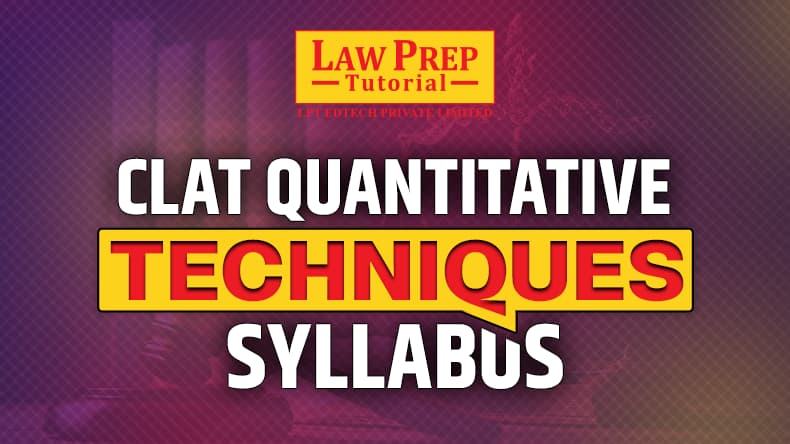The quantitative techniques in CLAT evaluate candidates’ basic math knowledge, including basic calculations, profit and loss, ratio and proportion, and more.
To crack the CLAT 2026 exam, scoring well in this section is important. So, a candidate should prepare this part with a good strategy and relevant study materials and practice the CLAT test series.
Upcoming CLAT Exams:
The questions in this section of the CLAT are less subjective and more straightforward. This part also has comprehension-type questions with given data and information in the passages, followed by multiple-choice questions. This section has the minimum weight of the entire paper.
CLAT Quantitative Techniques Syllabus: Highlights
- The passages will be short sets of propositions, facts, or other textual representations of numerical information, followed by MCQs.
- Candidates must derive information from the passages or questions and apply mathematical operations.
CLAT Quantitative Techniques Exam Pattern
Although the section carries around 10% weightage in the exam, it plays the role of a deciding factor for those aiming for law admissions at prestigious National Law Universities (NLUs).
Look at the CLAT 2026 Quantitative Techniques pattern:
| Particulars | Details |
| Number of Questions | 10-14 |
| Negative Marking | -0.25 (for each incorrect answer) |
| Difficulty Level | 10th Class |
| Types of Questions | Short sets of facts or propositions, or other textual representations of numerical information, followed by a series of questions |
Also Read: CLAT Quantitative Techniques Previous Year analysis
CLAT Quantitative Techniques Syllabus 2026
The Consortium of NLUs has specified that the quantitative techniques section of the CLAT will test the aspirant’s ability to:
- Obtain, deduce, and alter the numerical information given in passages.
- Perform mathematical operations.
- Capacity to separate useful from un-useful information.
Candidates should practice questions from the following CLAT quantitative techniques important topics to sharpen their numerical abilities and cover the CLAT syllabus 2026 thoroughly:
| Topics Covered | Details |
| Basic Arithmetic | Addition, Subtraction, Division, Multiplication, Number System, Decimals, Fraction and Functions Approximation, Roots, Surds and Indices, HCF and LCM, Average, Ratio and Proportion, Time and Work, Simplification, Logarithms, and Functions. |
| Commercial Mathematics | Percentage, Interest Calculation and Discounts, Partnership, Profit, Loss, etc. |
| Modern Mathematics | Clocks and Calender, Probability |
| Mensuration | Measurement, Volume, and Geometry. |
| Algebra | Basic Algebra and Its Applications |
Tips and Tricks to Attempt CLAT Quantitative Techniques Syllabus Questions
Below are a few tips to consider while attempting questions from the CLAT quantitative techniques syllabus section:
- Read the passage and the information provided carefully before attempting the subsequent questions.
- While reading the passage, mark or underline the facts, for instance, information on various speeds of trains in a passage.
- Always keep your rough notes and calculations neat and handy so you can refer to them for later questions.
Also Read: Timetable for CLAT Preparation
Tips to Prepare for CLAT Quantitative Techniques Syllabus 2026
Before preparing this section, remember the following points:
- Start the preparation for the mathematics section with NCERT’s basic 10th and 12th standard books.
- Follow good-quality, reliable CLAT study materials or references for this exam, comprehend the consequences of proper preparation, and become acquainted with the recent trends in mathematics questions.
- Arrange a study plan for each quantitative technique syllabus and section sub-topic and consistently follow it.
- Practice regularly with the CLAT quantitative techniques mock test series available offline and online by Law Prep Tutorial. Before the exam, attempt as many mock series as possible to enhance confidence and accuracy.
- Follow good, reliable CLAT preparation books or references.
- Always read the numerical problem properly, with full attention, and try to understand it. Otherwise, you may miss important details while solving it.
- Every topic in this section is equally important, so do not miss out on any topic and revise the topics regularly to grasp the concepts better.
- Relearn the fundamental concepts of elementary mathematics. To score well in this exam, basic knowledge and skills in mathematics are required.
- Time management is another important aspect of this exam. Try to solve the numerical questions about which you are fully confident.
- Maintain speed with accuracy. Do not go for guesswork or any assumption, as this may lead to losing a lot of marks.
- Before the examination, practice all the CLAT previous year’s question papers to get familiar with the question pattern and score well.
- Be focused, confident, and dedicated to preparation.
- The most important tip is not to panic or get stressed; just be calm, compose yourself, and prepare well.
CLAT Quantitative Techniques Books
As a law student, you must be able to differentiate if the particular book serves your purpose.
Some of the important books and study materials are given below:
| Book Name | Author Name |
| Quantitative Aptitude for Competitive Examinations (English) | RS Aggarwal |
| Data Interpretation | BSC Publications |
| Magical Book on Quicker Maths | M Tyra |
| Quantitative Aptitude for Competitive Examinations | Pearson’s |
CLAT Previous Year Papers
To help you prepare effectively and be ready for the CLAT exam date 2026, we have shared the collection of CLAT previous year papers. These papers provide valuable insights into the exam format and types of questions asked, helping you refine your study strategy.
Checkout CLAT previous Year papers of 18 years.
Important CLAT Questions for Practice:
| CLAT Legal Reasoning Questions | CLAT Logical Reasoning Questions |
| CLAT English Questions | CLAT GK Questions |
Important Resources After CLAT Exam:
CLAT Coaching Across Different Cities of India



